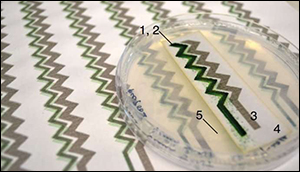Digitally printed cyanobacteria can power small electronic devices
27. 11. 2017 | Phys.org | www.phys.org
Researchers have used a simple inkjet printer to print a “bio-ink” of cyanobacteria onto a conductive surface, creating a biophotovoltaic cell. Unlike conventional photovoltaic cells that operate only when exposed to light, the cyanobacteria can generate an electric current both in the dark and in response to light.
The researchers expect that the cell may serve as an environmentally friendly power supply for low-power devices such as biosensors, and can even be scaled up to print a bioenergy wallpaper. The scientists, at Imperial College London and University of Cambridge, have published a paper on the new biophotovoltaic cell in a recent issue of Nature Communications.

“Our biophotovoltaic device is biodegradable and in the future could serve as a disposable solar panel and battery that can decompose in our composts or gardens,” coauthor Marin Sawa at University of Arts London and Imperial College London told Phys.org. “Cheap, accessible, environmentally friendly, biodegradable batteries without any heavy metals and plastics—this is what we and our environment really need but don't have just yet, and our work has shown that it is possible to have that.”
Read more at Phys.org
Image Credit: M. Sawa
-jk-




